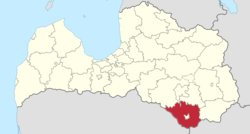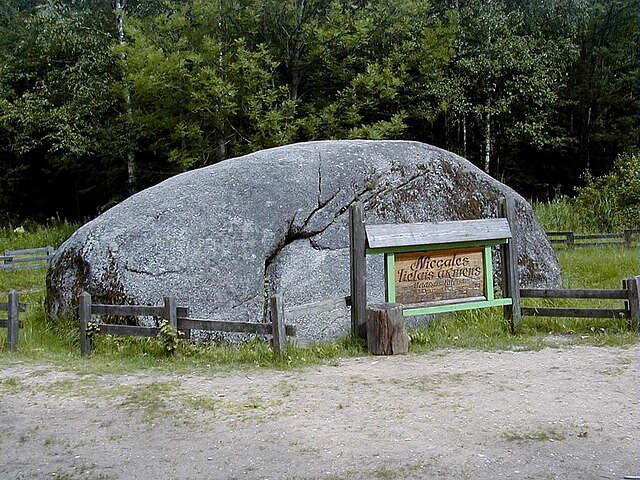Augšdaugava Municipality
Municipality of Latvia From Wikipedia, the free encyclopedia
Municipality of Latvia From Wikipedia, the free encyclopedia
Augšdaugava Municipality (Latvian: Augšdaugavas novads, "upper Daugava municipality") is one of the 35 municipalities established in Latvia in 2021. It surrounds the independent city of Daugavpils and its municipal headquarters are located there. Its first elected municipal council has taken office on 1 July 2021.
Augšdaugava Municipality
Augšdaugavas novads | |
|---|---|
 Augšzeme landscape in Svente Parish | |
 Location of Augšdaugava Municipality in Latvia | |
| Coordinates: 55.94°N 26.45°E | |
| Country | |
| Established | 1 July 2021 |
| Seat | Daugavpils (extraterritorially) |
| Government | |
| • Council Chair | Arvīds Kucins (DMP) |
| Area | |
| • Total | 2,524 km2 (975 sq mi) |
| Highest elevation | 220.6 m (723.8 ft) |
| Population | |
| • Estimate (1 January 2021)[1] | 25,927 |
| Time zone | UTC+2 (EET) |
| • Summer (DST) | UTC+3 (EEST) |
| Website | www |



Augšdaugava Municipality covers an area of 2,524 square kilometres (975 sq mi).[1] It is located in the southwestern part of the Latgale region in eastern Latvia, and surrounds the city of Daugavpils on all sides. It borders Jēkabpils Municipality to the northwest, Līvāni Municipality to the north, Preiļi Municipality to the northeast, and Krāslava Municipality to the east.[1] It also borders the Lithuanian counties of Panevėžys and Utena to the west and southwest respectively, and Vitebsk Region in Belarus to the southeast. The southernmost point of Latvia is located on the border with Lithuania in Demene Parish, and is commemorated with a nearby sculpture by Vilnis Titāns.[3]
The Augšzeme ("highland") region is located in the south-central part of the municipality and is a Protected Landscape with an area of 208.13 square kilometres (80.36 sq mi).[4] Lake Svente and Lake Medumi are found within the protected area. Also located in the area is Egļukalns, the highest point of the municipality[5] with an elevation of 220.6 metres (724 ft) above sea level.[2] It is the site of a ski resort.[6]
The Daugava flows into the municipality from the east and turns north at Daugavpils. The Daugava valley east of Daugavpils is a Protected Landscape Area which extends into Krāslava Municipality.[7]
A third Protected Landscape Area located in the northern part of the municipality is Nīcgale forest in Nīcgale Parish.[8] The Great Stone of Nīcgale is located on its eastern boundary and is the largest glacial erratic known in Latvia with a volume of approximately 170 cubic metres (6,000 cu ft).[9]
Augšdaugava Municipality corresponds in extent to the former Daugavpils District as it existed from 1967 to 2009. In the 2009 territorial reforms, Daugavpils District was divided into the municipalities of Daugavpils and Ilūkste. In 2020, the Saeima approved reducing the number of administrative divisions at the municipal level from 119 to 42, including rejoining the municipalities of Daugavpils and Ilūkste to form Augšdaugava Municipality.[10] Elections for Latvia's new municipal councils were held on 5 June 2021,[11] and the new municipalities including Augšdaugava went into effect on 1 July 2021.[10]

Augšdaugava Municipality elected 15 councillors in the 2021 local elections.[12] The municipality is to form joint authorities with the city of Daugavpils for the administration of civil protection, education, and waste management.[13]
The municipality is subdivided into two towns and 25 parishes:[10][13]
The Central Statistical Bureau of Latvia estimated a population of 25,927 living in what is now Augšdaugava Municipality at the beginning of 2021. This represented a 39% decrease from its estimated population of 42,483 at the beginning of 2000, and a 22% decrease from its estimated population of 33,222 at the beginning of 2011.[1]
The populations of the towns of Ilūkste and Subate were estimated to be 2169 and 596 respectively at the beginning of 2021.[14]
Augšdaugava is primarily an agricultural municipality: in 2005, 71% of the total area of the former Daugavpils District was used for agricultural purposes, mainly cereal and cattle farming.[5] The municipality is served by national roads A6, which connects Daugavpils to Jēkabpils and Riga to the northwest, and Krāslava and the Belarusian border to the east; A13, which runs from the Lithuanian border southwest of Daugavpils through Daugavpils and Rēzekne and the Russian border northeast of Kārsava; and A14, a western bypass of Daugavpils.[5] The Riga–Daugavpils gas pipeline and the defunct Unecha–Polotsk–Ventspils branch of the Druzhba oil pipeline also run through the municipality.[5][15] Daugavpils International Airport is located at Lociki in Augšdaugava Municipality northeast of Daugavpils.
Seamless Wikipedia browsing. On steroids.
Every time you click a link to Wikipedia, Wiktionary or Wikiquote in your browser's search results, it will show the modern Wikiwand interface.
Wikiwand extension is a five stars, simple, with minimum permission required to keep your browsing private, safe and transparent.